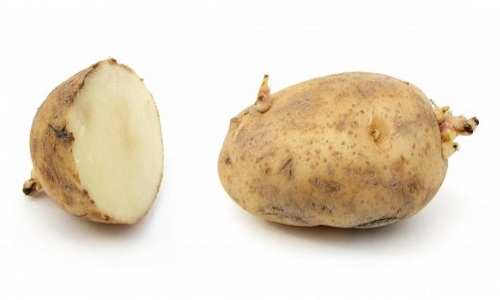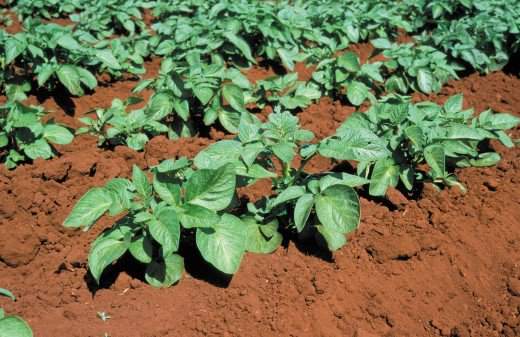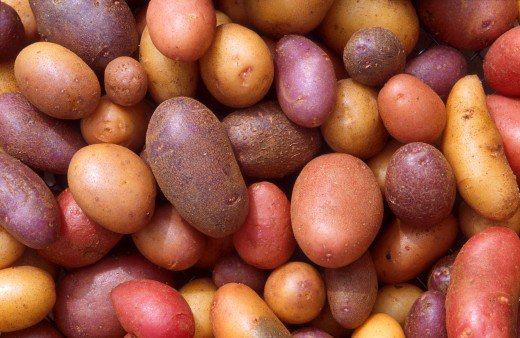Potatoes are one of the easiest and most abundant foods you can grow. They can be a side dish or dressed up to be a complete meal.

They also keep pretty well. If you are looking for a simple item to grow that will also bulk up your pantry, potatoes are a great staple. Here are several different ways to grow potatoes, no matter where you live.
Which Potato Growing Method is Right for You?
|
Straw Bale Method
|
Container Method
|
Scatter Method
|
|---|---|---|
|
Somewhat labor intensive
|
Less Labor Intensive
|
Less labor intensive
|
|
Inexpensive
|
Some expense for materials
|
Inexpensive if you have mulch
|
|
Space efficient
|
Space efficient
|
Requires space
|
Straw Bale
Growing potatoes (or anything) in straw bales is an easy, inexpensive and eco-friendly way to get your garden started. When done correctly, it also produces a magnificent yield. You don’t need fresh bales. Because you want straw to be aged for this method anyway, you can usually get older bales that have been exposed to the elements and that farmers are desperate to get rid of anyway.
- Obtain straw bales. A good rule of thumb is two to three plants per bale, so keep that in mind when determining how many bales you will need.
- Place your bales. They will need at least six hours of sunlight a day and once they are wet, they will be too heavy to move. Once you have decided where to place your bales, lay some news paper or weed barrier on the ground to prevent weeds from growing up through your bales.
- Condition your bales. If your bale is at least a year old, you can skip this step. If your bale is new, wet it down every day for about 2 weeks. You will want the bales to remain constantly moist, so water as needed each day. On days three through nine, add a nitrogen fertilizer once a day. You should water bales well enough that they are moist but not so much that water and fertilizer go running out. Conditioning the bale helps the bales begin to decompose. At the beginning of this process you may notice the straw bales heating up. Before planting, however, use a thermometer or your hand to make sure that the inside of the bale is below body temperature.
- Plant your seed potatoes. Cut potatoes into chunks with at least one “eye” on each piece. Let pieces set for 24 hours so that cut sides may dry before planting. Place cuttings six inches into bale. Water regularly. You may also fertilize bales with 10-10-10 fertilizer every three weeks or so.
- Harvest. When plants begin to wither and die, this is a sign that your potatoes are ready to harvest. You can cut the strings on the bales and allow the bales to fall apart. You will be able to harvest your potatoes with out any digging.
Straw Bale Gardening
Container Gardening
Yes, you can grow potatoes in containers. People who chose this method generally do so because they don’t have much space. A gardening container can be placed on a patio or even a balcony. You might also chose this method of growing potatoes if you don’t have a whole lot of time to spend on gardening. This method makes it easier to protect your plants from pests and makes weeding virtually unnecessary. You can use any clean container from a garbage can to a feed sack. The rule is that you have to get it to stand up and it has to have good drainage. You may need to make holes in your container to get it to drain properly.
- Fill your (clean and ventilated) container with potting soil and a healthy dose of fertilizer. You can also add hay to the mix to keep the soil from getting too compacted.
- Plant your potatoes. Cut your seed potatoes into chunks that are at least the size of your thumb and press them about six inches into the soil.
- Tend your plants. This includes (but is not limited to) watering, fertilizing and “hilling.” Your soil should remain moist but not too wet. Dry soil will cause your plants to wilt, but too much water will turn your potatoes into mush. As plants grow, continue to add soil around them. Because potatoes grow from the stem of the plant making sure to keep the stem covered will ensure that new potatoes have a chance grow. Potato plants like sunlight, potatoes do not.
- Harvest. When plants begin to die, your potatoes are ready.
Growing Potatoes in Containers
Traditional Trench Method
This is the time honored “traditional” method for growing potatoes. It is a great way to go if you have space and like to spend time in the garden. Because there is plenty of space for plants to spread out, it carries the greatest potential for a plentiful harvest.
- Dig a trench six inches deep.
- Place cut seed potatoes in the trench, eyes up. Cover with a couple inches of soil.
- As plants grow, continue to pull soil up around them to prevent new spuds from being exposed to the sun. Exposure to sunlight will cause developing potatoes to turn green which will make them a little bit poisonous. You probably won’t die, but they won’t be very good potatoes.
- Harvest.

Scatter Method
This one is for the truly lazy gardener. Simply scatter seed potatoes over the gardening space and cover them with mulch. As with other methods, you will need to continue adding mulch as plants grow. One caveat: if you have a problem with pests such as mice or moles, this method should not be your first choice.
You don’t need a lot of time, money, space or talent. No matter what your skills or means or how much space you have, anyone can grow potatoes. With the right gardening method and a little attention, you can have a fine harvest of potatoes to grace your table and supplement your pantry.
Potatoes!

Source : dengarden.com
Want to go completely off-grid and be as self-sufficient as possible? Then you really need this amazing step-by-step guide. It is called The Lost Ways and it contains all the knowledge of our forefathers.
Here’s just a glimpse of what you’ll find in The Lost Ways:
From Ruff Simons, an old west history expert and former deputy, you’ll learn the techniques and methods used by the wise sheriffs from the frontiers to defend an entire village despite being outnumbered and outgunned by gangs of robbers and bandits, and how you can use their wisdom to defend your home against looters when you’ll be surrounded.
Native American ERIK BAINBRIDGE – who took part in the reconstruction of the native village of Kule Loklo in California, will show you how Native Americans build the subterranean roundhouse, an underground house that today will serve you as a storm shelter, a perfectly camouflaged hideout, or a bunker. It can easily shelter three to four families, so how will you feel if, when all hell breaks loose, you’ll be able to call all your loved ones and offer them guidance and shelter? Besides that, the subterranean roundhouse makes an awesome root cellar where you can keep all your food and water reserves year-round.
From Shannon Azares you’ll learn how sailors from the XVII century preserved water in their ships for months on end, even years and how you can use this method to preserve clean water for your family cost-free.
Mike Searson – who is a Firearm and Old West history expert – will show you what to do when there is no more ammo to be had, how people who wandered the West managed to hunt eight deer with six bullets, and why their supply of ammo never ran out. Remember the panic buying in the first half of 2013? That was nothing compared to what’s going to precede the collapse.
From Susan Morrow, an ex-science teacher and chemist, you’ll master “The Art of Poultice.” She says, “If you really explore the ingredients from which our forefathers made poultices, you’ll be totally surprised by the similarities with modern medicines.” Well…how would you feel in a crisis to be the only one from the group knowledgeable about this lost skill? When there are no more antibiotics, people will turn to you to save their ill children’s lives.
And believe it or not, this is not all…
Table Of Contents:
Making Your Own Beverages: Beer to Stronger Stuff
Ginger Beer: Making Soda the Old Fashioned Way
How North American Indians and Early Pioneers Made Pemmican
Spycraft: Military Correspondence During The 1700’s to 1900’s
Wild West Guns for SHTF and a Guide to Rolling Your Own Ammo
How Our Forefathers Built Their Sawmills, Grain Mills,and Stamping Mills
How Our Ancestors Made Herbal Poultice to Heal Their Wounds
What Our Ancestors Were Foraging For? or How to Wildcraft Your Table
How Our Ancestors Navigated Without Using a GPS System
How Our Forefathers Made Knives
How Our Forefathers Made Snow shoes for Survival
How North California Native Americans Built Their Semi-subterranean Roundhouses
Our Ancestors’Guide to Root Cellars
Good Old Fashioned Cooking on an Open Flame
Learning from Our Ancestors How to Preserve Water
Learning from Our Ancestors How to Take Care of Our Hygiene When There Isn’t Anything to Buy
How and Why I Prefer to Make Soap with Modern Ingredients
Temporarily Installing a Wood-Burning Stove during Emergencies
Making Traditional and Survival Bark Bread…….
Trapping in Winter for Beaver and Muskrat Just like Our Forefathers Did
How to Make a Smokehouse and Smoke Fish
Survival Lessons From The Donner Party
Get your paperback copy HERE
CHECK OUR survival and prepping solutions
If you found this article useful, please like our Facebook page and stay up to date with the latest articles.
WHAT TO READ NEXT :
- HOW TO CAN FRESH SMALL POTATOES
- GROWING POTATOES IN STRAW: A LABOR-SAVING/BETTER HARVEST TECHNIQUE
- SURVIVAL COOKING: HOW TO USE A DUTCH OVEN
- 6 BASIC RECIPES TO PREPARE OFF-GRID
- LESSONS FROM HISTORY – EATING WELL OFF HOME FOOD PRESERVATION
- INGENIOUS FOODS PEOPLE MADE DURING FAMINES
- HOMESTEADING SKILLS TO LEARN FROM PIONEERS

These days I would be lerry of the straw bale method. Many fields are now sprayed a long lasting herbicide. So long lasting in fact that even if the straw or hay is consumed by ruminants the effect of the herbicide remains intact.